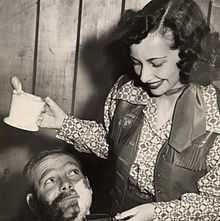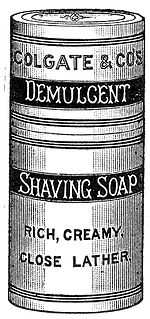Shaving soap
- This article is about traditional, solid shaving soaps. For soft shaving creams, see shaving cream.

Shaving soap typically refers to a hard soap that is whipped into a lather using a shaving brush. The lather it produces is used to coat the face during shaving, providing protection and lubrication for the razor. Among most wet shavers, shaving soap has largely been displaced by canned shaving foam or gel, but hard shaving soaps have a following among shaving traditionalists especially among straight razor users.[1]
History
Hard shaving soaps in their modern form have existed since at least the early 19th century. Williams (a common American shaving soap intended for use in a mug rather than a scuttle) has been produced since 1840,[2] and a US patent for a shaving scuttle for use with a hard soap was granted in 1867.[3]
Shaving sticks (shaving soap formed into a cylinder) have existed at least since the mid-19th century. [4]
Appearance


Traditional shaving soap is often sold as a round puck, either with a rounded bottom intended for use with a shaving scuttle or a flat bottom for use in a mug. High-end soaps may be sold with their own dishes, typically made of either wood or ceramic, and be formed to fit the dish the puck is sold with. Shaving soap may also be formed in a stick, sold either in a plastic tube or wrapped in foil or paper. Shaving soap is more rarely sold as rectangular bars (as is common with body soap).
Use
A hard shaving soap is used with a shaving brush to create lather for shaving. For soap in the form of a puck or bar, the brush is first soaked in water and then swirled vigorously over the surface of the soap, causing moist soap to coat the brush's bristles. The brush is then transferred either to a separate bowl or to the shaver's face to be lathered.
Shaving sticks are typically used by rubbing the exposed end of the stick across the shaver's face, coating the face with soap. The soap is then lathered with a moistened brush. Owing to their compact form and ease of use, shaving sticks are popular for use while traveling.
Ingredients
A shaving soap is produced like a traditional soap with an ingredient selection oriented to producing a stable, slick lather. Its manufacture differs slightly from normal bath soap in that both potassium hydroxide and sodium hydroxide are used as saponification agents rather than just sodium hydroxide alone. Traditionally, tallow has been a popular ingredient in shaving soaps and is still in use in some traditional products. Other oils such as coconut oil, palm oil, and olive oil are often used in shaving soap, but such oils are thought among shaving traditionalists to often produce an inferior product. In addition, unlike aerosol shaving cream in a can, shaving soaps are not limited by TSA carry-on luggage rules as they do not contain a petro-chemical propellant.
With the controversy over parabens, many soap-makers have started using other preservatives and advertising their soaps as paraben-free.
Advantages and disadvantages
The primary advantages of shaving soap over aerosol shaving creams is the additional hydration provided by shaving soaps. For optimal softening of whiskers, the natural oils on the face and whiskers must be removed. After oil is removed from the whiskers by the shaving soap and brush, water can more easily penetrate the whiskers. This results in whiskers being more easily cut than when using soapless creams and not brushing.
Shaving soaps are also approved by the Transportation Security Administration and other airport security agencies as permitted in carry-on luggage. There is furthermore little risk of accidental discharge of the product during transport.
The principal disadvantages of shaving soap is lack of convenience and space. Creating the lather and preparing the face is more time consuming than with other shaving creams. In addition, use of a shaving mug and optionally a lather bowl, consumes more space and takes more time than most shaving creams do.
Shaving soaps typically cost more initially, when the shaving mug and soap is purchased. These costs can be significantly reduced by using mugs and bowls found in the kitchen, or purchased for a small amount at resale stores.
Even though shaving soaps may cost more initially when buying the soap and equipment, over a longer period of time, shaving soaps are comparable in cost, or even cheaper than many shaving creams.
Furthermore shaving soaps have less ecological impact with respect to aerosol shaving creams.
See also
| Wikibooks has a book on the topic of: Shaving |
- Aftershave
- Barber
- Bay rum
- Beard
- Burma-Shave
- Colognes
- Head shaving
- Leg shaving
- Razors
- Shaving cream
- Shaving oil
- Straight razor
References
- ↑ http://atcemsce.org/is-parker-sr1-the-best-straight-edge-razor-on-the-planet/
- ↑ "Williams Mug Soap product website". Retrieved 2010-11-05.
- ↑ J. P. Brooks and J. McGrady "Improvement in shaving-cups" U.S. Patent 66,788 Issue date: July 1867
- ↑ "Advertisement from 1849 for Pear's Shaving Stick". Retrieved 2010-11-12.
| ||||||||||||||||||||||||||||||||||||||